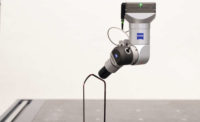Introducing E-Mobility Inspection
Meet the quality inspection solutions for all components of E-Mobility: Battery, Power Electronics, E-Motor and Transmission.

If you’re not sure how to inspect components for E-mobility applications, there are a range of tools at the ready. As the world of electric vehicles continues to expand, technologies such as computed tomography, coordinate measuring machines, and microscopes all provide part of the puzzle.
Many major automakers are partnering up in the race for the electric vehicle market, and one common theme with E-vehicles is a tight timeline. E-vehicles are all aiming to come to market quickly. Nowadays, as mentioned in the BBC, partnerships such as GM and Honda, Ford and VW, and the most recent announcement, a partnership between GM and LG Chem, shows that the electric vehicle market is a crowded one.
With so much competition, quality is obviously critical. And with quality comes inspection. The inspection solutions industry has grown alongside the electric vehicle market.
Lars Virgin, application engineer, at ZEISS Industrial Quality Solutions, explains that while the electric vehicle applications are new, the technologies themselves have been tried and tested.
The most common reaction, he says, is people asking about the technology because they think it is unproven. “It’s a transition from what they’re comfortable with. From tactile, moving into optical inspection, most people think it is new so they question it,” Virgin says. “All these optical sensors are not new for ZEISS. We’ve all used them before.”
Still, inspections for E-mobility applications involves a few adjustments. In other words, when adopting inspection equipment for this type of application, there are a few things to keep in mind.
As Virgin explains, when shifting from a combustion engine to an electric vehicle, the biggest switch is using optical inspection rather than tactile. Since electric motor components are more fragile, it’s important not to touch the components during inspection. In terms of getting starting on the inspection plan, it is otherwise the same process, he notes.
The benefits of the technology
Through laser triangulation, the laser is really good at acquiring a point cloud, and is capable of taking 50,000 measurements, Virgin says. Other pieces of technology used with electric motors include a CT systems, which can be used in line at a manufacturing facility.
“With CT inspection, obviously the benefit is to be able to look directly through your part and see the internals without destroying the part,” Virgin notes. In addition to CT, microscopes provide additional options.
For example, the electron microscope can be used in battery inspection. “With an electron microscope, you can zoom down into nanometers into the structures itself, and are able to detect what elements, what the battery material is made out of, and look through the aging battery as it is being used,” Virgin notes. It’s possible to cycle through the battery 100 times and observe what happens to the components.
“Typically when talking about battery inspection, it’s more common to look at microscopes,” Virgin says. “For power electronics, CT is a strong benefit. With nondestructive testing, if something went wrong, you can look inside where something went wrong without having to open up that component.” For example, he says it’s possible to make sure the connection points are strong so that they aren’t accidentally unplugged while someone is driving.
“The big difference between the combustion engine transmission and electric vehicle motor transmission is the reduction in gears,” Virgin says. Rather than having thousands of components, electric vehicles have significantly fewer gears. By no longer having combustion in the engine, the motor is silent and thus companies are working on reducing noise from the transmission. This may entail using a CMM surface finish probe and changing the stylus to meet more stringent surface finish requirements.
Options Abound
No matter what component needs to be inspected, it’s likely that there is a proven technology to help companies achieve their measuring goals. It just comes down to the specific application they are using them for.
“The biggest thing to note is that every customer is different,” Virgin notes. Until the application engineers are able to talk with them and distinguish what the application requires, there is no way to know exactly what technology is required.
Electric vehicle is one of four main initiative from ZEISS—along with aerospace, medical and additive manufacturing—and CT is becoming more and more common for this type of application. CT can be used to inspect weld seams between hairpins, for example. An electric vehicle motor may have 100 hairpins, all welded together into a circuit, he explains. With a CT machine, it is possible to scan all of these together for porosity or any loose areas.
While CT has been around for a while, it’s typically more expensive. But with this type of application, customers will see a lot of value from the technology. “They’ve been inspecting porosity,” Virgin says. “Porosity is huge for CT.”
While CT was previously used for combustion engines, “It’s just as useful for these housings,” Virgin notes. “It’s another new application we can apply it to.”
Looking for a reprint of this article?
From high-res PDFs to custom plaques, order your copy today!






